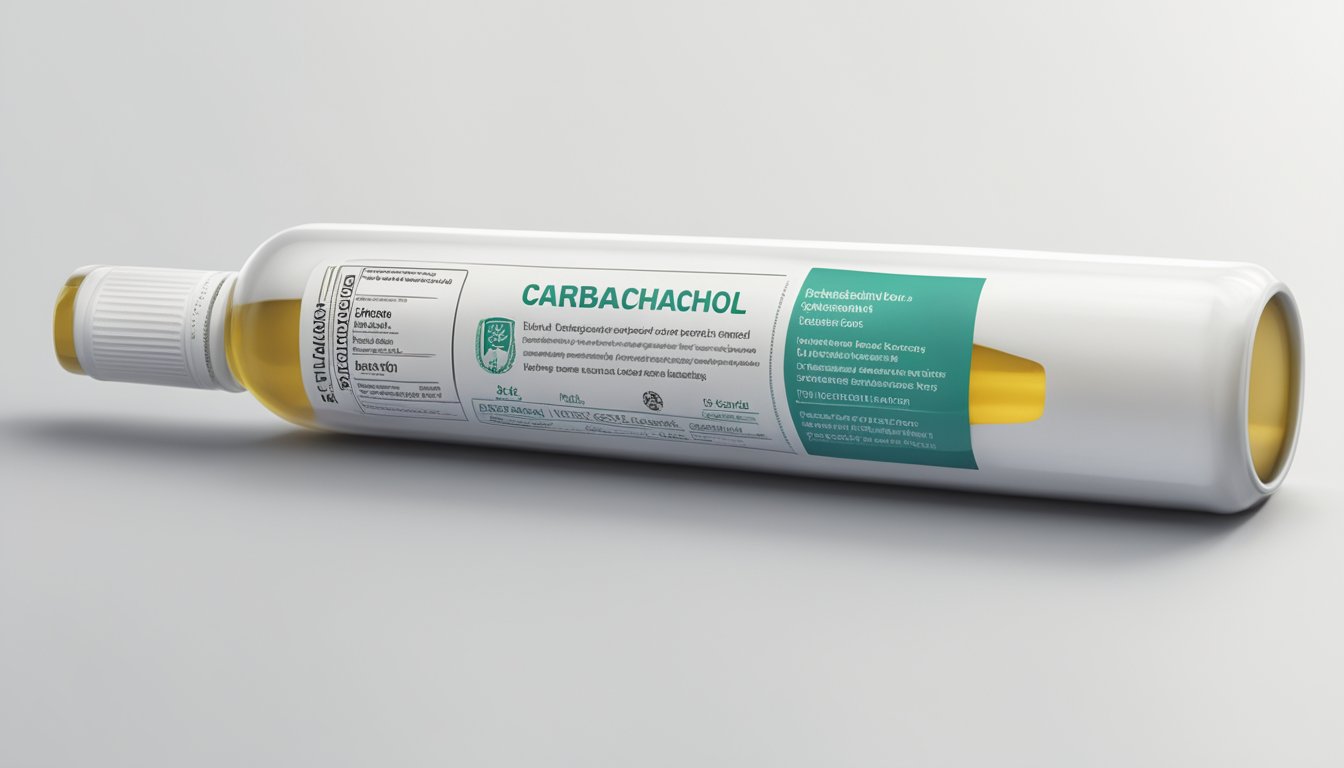If you or someone you know has been prescribed Carbachol, you may be wondering about the different brand names available for this medication. Carbachol is a cholinergic agonist that is primarily used for ophthalmic purposes, such as treating glaucoma or during ophthalmic surgery. It binds and activates acetylcholine receptors, making it a useful treatment for these conditions.

There are several brand names for Carbachol, including Miostat and Isopto Carbachol. These brand names may be more familiar to you than the generic name, Carbamylcholine. It is important to note that all of these brand names contain the same active ingredient and are used for the same clinical indications.
Overall, knowing the different brand names for Carbachol can be useful when discussing treatment options with your healthcare provider. It is important to follow your doctor’s instructions regarding dosage and administration, as well as any safety and precautionary measures that may be necessary.
Key Takeaways
- Carbachol is a cholinergic agonist used for ophthalmic purposes, such as treating glaucoma or during ophthalmic surgery.
- The brand names for Carbachol include Miostat and Isopto Carbachol, among others.
- It is important to follow your doctor’s instructions regarding dosage, administration, and safety measures when taking Carbachol.
Clinical Uses and Indications

Carbachol is a medication that is primarily used for ophthalmic purposes, such as treating glaucoma and aiding in cataract surgery. It is a direct acting miotic agent that can decrease intraocular pressure and induce miosis during surgery.
Glaucoma Treatment
Glaucoma is a condition that occurs when there is an increase in intraocular pressure, which can damage the optic nerve and lead to vision loss. Carbachol is an effective treatment for glaucoma as it helps to decrease intraocular pressure by increasing the outflow of aqueous humour from the eye.
Carbachol is typically administered as eye drops and can be used alone or in combination with other medications to treat glaucoma. It is important to note that carbachol can cause side effects such as blurred vision, eye irritation, and headache, so patients should be monitored closely while taking this medication.
Cataract Surgery Aid
Carbachol is also used as an aid during cataract surgery to induce miosis, which helps to prevent damage to the iris and other structures in the eye. During cataract surgery, carbachol is typically administered as an injection into the eye.
Carbachol is a safe and effective medication for use during cataract surgery, but it can cause side effects such as eye pain, redness, and swelling. Patients should be monitored closely for any adverse effects while taking this medication.
Overall, carbachol is an important medication for the treatment of glaucoma and as an aid during cataract surgery. It is important for patients to speak with their healthcare provider about the risks and benefits of taking carbachol and to be monitored closely while taking this medication.
Pharmacological Profile

Carbachol is a cholinergic agonist that binds and activates acetylcholine receptors. It is primarily used for various ophthalmic purposes, such as treating glaucoma or for use during ophthalmic surgery.
Mechanism of Action
Carbachol acts on both muscarinic and nicotinic receptors in the parasympathetic nervous system. It mimics the action of acetylcholine, which is the primary neurotransmitter in the parasympathetic nervous system.
At muscarinic receptors, carbachol activates G-proteins, which then activate phospholipase C. This leads to the release of inositol triphosphate and diacylglycerol, which then activate intracellular calcium release and protein kinase C, respectively.
At nicotinic receptors, carbachol activates ion channels, leading to the influx of sodium and calcium ions and the efflux of potassium ions, ultimately leading to depolarization of the cell membrane.
Drug Class and Pharmacokinetics
Carbachol is a quaternary ammonium compound and a choline carbamate. It is classified as a parasympathomimetic and a cholinergic agonist.
Carbachol is administered as an ophthalmic solution and is absorbed through the cornea. It has a rapid onset of action and a short duration of action. The drug is metabolized by cholinesterases in the plasma and tissues, and the metabolites are excreted in the urine.
In conclusion, carbachol is a potent cholinergic agonist that acts on both muscarinic and nicotinic receptors in the parasympathetic nervous system. It is primarily used for ophthalmic purposes and has a rapid onset of action and short duration of action. The drug is metabolized by cholinesterases and excreted in the urine.
Dosage and Administration

Carbachol is a medication that is available in the form of ophthalmic solution and intraocular injection. The dosage and administration of carbachol may vary depending on the condition being treated, and it is important to follow the instructions provided by your healthcare provider or pharmacist.
Ophthalmic Solution
Carbachol ophthalmic solution is used to treat miosis during surgery and reduce postoperative rises in intraocular pressure. The dosage of carbachol ophthalmic solution is usually one to two drops in the affected eye(s), up to four times daily. The solution should be instilled into the eye(s) before or after securing sutures.
Intraocular Injection
Carbachol intraocular injection is used to treat open-angle glaucoma. The dosage of carbachol intraocular injection is usually 0.5 to 1 mL into the anterior chamber of the affected eye(s), administered by a healthcare professional. The injection should be given under sterile conditions.
It is important to note that carbachol is a prescription medication and should only be used as directed by a healthcare provider. It is classified as an ophthalmic glaucoma agent and has the ATC code S01EB02.
Carbachol has been approved by regulatory authorities for use as a miotic and direct-acting parasympathomimetic agent. When using carbachol, it is important to follow the dosage and administration instructions provided by your healthcare provider or pharmacist to ensure safe and effective treatment. The cost of carbachol may vary depending on the brand name and supplier, but it is typically priced at around $XX for a XX mL bottle.
Safety and Precautionary Measures

Carbachol is a medication that can be helpful in treating various medical conditions. However, it is important to take necessary precautions and follow safety measures when using this medication. In this section, we will discuss some of the important safety measures you should take when using Carbachol.
Contraindications and Warnings
Before using Carbachol, it is important to take note of any contraindications and warnings associated with this medication. Carbachol should not be used if you are allergic to it or any of its components. It is important to inform your healthcare provider of any allergies you may have to avoid any adverse reactions.
Carbachol can cause sweating, headache, blurred vision, and potentially serious side effects. If you experience any of these symptoms, it is important to inform your healthcare provider immediately.
Potential Side Effects
Carbachol can cause a range of side effects. Some of the common side effects include hives, swelling, and other allergic reactions. Other potential side effects include nausea, vomiting, and diarrhea. If you experience any of these symptoms, it is important to inform your healthcare provider immediately.
It is important to take necessary precautions when using Carbachol. This medication can be toxic if ingested, so it should be kept out of reach of children and pets. If you are pregnant or breastfeeding, it is important to inform your healthcare provider before using this medication.
Overall, Carbachol is a helpful medication that can be used to treat a range of medical conditions. However, it is important to take necessary precautions and follow safety measures to avoid any adverse effects. By taking necessary precautions and following safety measures, you can ensure that you are using this medication safely and effectively.
Drug Interactions and Considerations

Carbachol has moderate interactions with at least 66 other drugs. It is important to inform your healthcare provider of all medications, supplements, and herbal products you are taking before using carbachol. Some medications that may interact with carbachol include desipramine, donepezil, galantamine, pantothenic acid, procainamide, and trazodone.
Interactions with Other Medications
Carbachol may interact with other medications, which can increase the risk of side effects or affect the way the medication works. For example, carbachol may interact with medications used to treat Parkinson’s disease, such as levodopa, or medications used to treat asthma, such as albuterol. It is important to inform your healthcare provider of all medications you are taking before using carbachol.
Special Populations
Carbachol should be used with caution in certain populations, including pregnant or breastfeeding women, children, and individuals with certain medical conditions. It is important to inform your healthcare provider of any personal circumstances or medical conditions you have before using carbachol.
In conclusion, carbachol has moderate interactions with other medications and should be used with caution in certain populations. It is important to inform your healthcare provider of all medications, supplements, and herbal products you are taking before using carbachol to reduce the risk of side effects and ensure the medication works effectively.
Frequently Asked Questions

What conditions does carbachol typically treat?
Carbachol is primarily used to treat glaucoma, a condition that causes damage to the optic nerve and can lead to vision loss. It is also used during eye surgery to constrict the pupil and reduce the risk of complications.
How does carbachol interact with the body to achieve its effects?
Carbachol works by stimulating the muscarinic receptors in the body, which leads to the contraction of the smooth muscle in the eye. This contraction reduces the pressure in the eye, making it an effective treatment for glaucoma.
Can you outline the recommended dosages for carbachol?
The recommended dosage of carbachol will depend on the condition being treated and the patient’s individual needs. For glaucoma, the usual dose is one or two drops in the affected eye(s) two to four times daily. During eye surgery, carbachol is typically administered as a single dose.
Could you list the potential side effects when using carbachol?
Like all medications, carbachol can cause side effects. The most common side effects include blurred vision, eye irritation, and stinging or burning in the eye. In rare cases, carbachol can cause more serious side effects such as headache, nausea, vomiting, and difficulty breathing. If you experience any of these symptoms, seek medical attention immediately.
What are the main reasons carbachol might be contraindicated for a patient?
Carbachol is contraindicated in patients who have a known hypersensitivity to the medication or any of its components. It should also be used with caution in patients with asthma, chronic obstructive pulmonary disease (COPD), or other respiratory conditions, as it can cause bronchospasms.
Into which pharmacological category does carbachol fall?
Carbachol is classified as a cholinergic agonist and is part of the pharmacological class of ophthalmic glaucoma agents.




